Which Of The Following Combinations Of Assets Is Considered To Be Money?
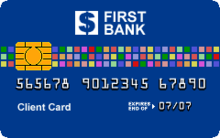
A sample film of a fictional ATM card. The largest part of the world's money exists only as accounting numbers which are transferred between financial computers. Various plastic cards and other devices give individual consumers the ability to electronically transfer such money to and from their bank accounts, without the employ of currency.

In a 1786 James Gillray caricature, the plentiful money numberless handed to Male monarch George III are assorted with the beggar whose legs and artillery were amputated, in the left corner
Money is any particular or verifiable tape that is generally accustomed as payment for appurtenances and services and repayment of debts, such as taxes, in a particular country or socio-economic context.[1] [2] [3] The primary functions of money are distinguished equally: a medium of exchange, a unit of account, a store of value and sometimes, a standard of deferred payment.[4] [5] Any item or verifiable record that fulfils these functions tin can exist considered every bit money.
Money is historically an emergent market place phenomenon establishing a commodity money, but nearly all gimmicky money systems are based on fiat coin.[four] Fiat money, similar any check or notation of debt, is without use value as a physical commodity.[ citation needed ] It derives its value past being declared by a government to exist legal tender; that is, information technology must be accepted as a form of payment inside the boundaries of the country, for "all debts, public and private".[6] [ better source needed ] Counterfeit money can cause good money to lose its value.
The money supply of a land consists of currency (banknotes and coins) and, depending on the particular definition used, one or more types of bank coin (the balances held in checking accounts, savings accounts, and other types of bank accounts). Banking company money, which consists just of records (more often than not computerized in modernistic cyberbanking), forms by far the largest part of broad money in developed countries.[7] [8] [9]
Etymology
The discussion coin derives from the Latin word moneta with the pregnant "coin" via French monnaie. The Latin word is believed to originate from a temple of Juno, on Capitoline, one of Rome'due south seven hills. In the ancient globe, Juno was oftentimes associated with money. The temple of Juno Moneta at Rome was the place where the mint of Ancient Rome was located.[10] The name "Juno" may take derived from the Etruscan goddess Uni (which means "the one", "unique", "unit", "union", "united") and "Moneta" either from the Latin word "monere" (remind, warn, or instruct) or the Greek give-and-take "moneres" (alone, unique).
In the Western world a prevalent term for coin-coin has been specie, stemming from Latin in specie, significant 'in kind'.[eleven]
History

The use of barter-like methods may date back to at to the lowest degree 100,000 years ago, though there is no show of a guild or economy that relied primarily on barter.[12] [13] Instead, not-budgetary societies operated largely along the principles of souvenir economic system and debt.[14] [15] When barter did in fact occur, it was usually between either complete strangers or potential enemies.[16]
Many cultures around the world eventually developed the use of commodity coin. The Mesopotamian shekel was a unit of weight, and relied on the mass of something similar 160 grains of barley.[17] The first usage of the term came from Mesopotamia circa 3000 BC. Societies in the Americas, Asia, Africa and Australia used shell money – often, the shells of the cowry (Cypraea moneta 50. or C. annulus L.). According to Herodotus, the Lydians were the first people to introduce the apply of gilded and silver coins.[18] It is idea by mod scholars that these beginning stamped coins were minted around 650 to 600 BC.[19]
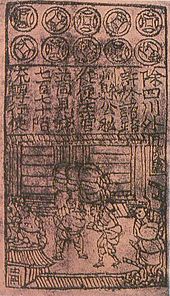
Song Dynasty Jiaozi, the earth's earliest newspaper money
The system of article money somewhen evolved into a organization of representative money.[ citation needed ] This occurred considering gold and silver merchants or banks would issue receipts to their depositors – redeemable for the commodity money deposited. Eventually, these receipts became by and large accustomed as a means of payment and were used as money. Paper money or banknotes were kickoff used in China during the Song dynasty. These banknotes, known as "jiaozi", evolved from promissory notes that had been used since the 7th century. However, they did not displace article money and were used alongside coins. In the 13th century, paper money became known in Europe through the accounts of travellers, such as Marco Polo and William of Rubruck.[20] Marco Polo's business relationship of newspaper money during the Yuan dynasty is the field of study of a chapter of his book, The Travels of Marco Polo, titled "How the Great Kaan Causeth the Bark of Copse, Made Into Something Like Paper, to Pass for Money All Over his Land."[21] Banknotes were starting time issued in Europe by Stockholms Banco in 1661 and were once again besides used alongside coins. The gilded standard, a monetary system where the medium of exchange are paper notes that are convertible into pre-prepare, fixed quantities of gold, replaced the utilize of gold coins equally currency in the 17th–19th centuries in Europe. These gold standard notes were made legal tender, and redemption into gold coins was discouraged. By the beginning of the 20th century, most all countries had adopted the gold standard, bankroll their legal tender notes with fixed amounts of gold.
After World War II and the Bretton Forest Conference, most countries adopted fiat currencies that were fixed to the U.Southward. dollar. The U.Due south. dollar was in turn stock-still to gold. In 1971 the U.S. regime suspended the convertibility of the dollar to golden. After this many countries de-pegged their currencies from the U.S. dollar, and nigh of the earth'south currencies became unbacked by annihilation except the governments' fiat of legal tender and the ability to catechumen the money into goods via payment. According to proponents of modern money theory, fiat money is besides backed by taxes. By imposing taxes, states create need for the currency they issue.[22]
Functions
In Money and the Mechanism of Commutation (1875), William Stanley Jevons famously analyzed money in terms of four functions: a medium of commutation, a common measure of value (or unit of measurement of business relationship), a standard of value (or standard of deferred payment), and a store of value. Past 1919, Jevons'southward four functions of money were summarized in the couplet:
- Money'southward a matter of functions four,
- A Medium, a Measure, a Standard, a Store.[23]
This couplet would later become widely popular in macroeconomics textbooks.[24] About modern textbooks now listing only 3 functions, that of medium of exchange, unit of account, and store of value, not because a standard of deferred payment equally a distinguished role, but rather subsuming it in the others.[4] [25] [26]
In that location take been many historical disputes regarding the combination of money's functions, some arguing that they demand more separation and that a single unit is insufficient to deal with them all. 1 of these arguments is that the part of coin as a medium of exchange conflicts with its part as a shop of value: its office as a store of value requires holding information technology without spending, whereas its role equally a medium of exchange requires it to circulate.[5] Others argue that storing of value is just deferral of the exchange, merely does not diminish the fact that coin is a medium of commutation that tin can exist transported both across space and fourth dimension. The term "financial upper-case letter" is a more general and inclusive term for all liquid instruments, whether or not they are a uniformly recognized tender.
Medium of exchange
When money is used to intermediate the exchange of goods and services, information technology is performing a part every bit a medium of exchange. It thereby avoids the inefficiencies of a barter organisation, such every bit the inability to permanently ensure "coincidence of wants". For example, between 2 parties in a barter organisation, one party may not have or make the particular that the other wants, indicating the non-existence of the coincidence of wants. Having a medium of exchange can convalesce this issue considering the former can take the freedom to spend time on other items, instead of being burdened to merely serve the needs of the latter. Meanwhile, the latter can employ the medium of substitution to seek for a political party that can provide them with the item they want.
Measure out of value
A unit of business relationship (in economic science)[27] is a standard numerical monetary unit of measurement of the market value of goods, services, and other transactions. Besides known every bit a "measure out" or "standard" of relative worth and deferred payment, a unit of account is a necessary prerequisite for the formulation of commercial agreements that involve debt.
Money acts equally a standard measure and a common denomination of trade. It is thus a footing for quoting and bargaining of prices. It is necessary for developing efficient accounting systems.
Standard of deferred payment
While standard of deferred payment is distinguished by some texts,[five] particularly older ones, other texts subsume this under other functions.[4] [25] [26] [ description needed ] A "standard of deferred payment" is an accepted way to settle a debt – a unit in which debts are denominated, and the condition of coin as legal tender, in those jurisdictions which have this concept, states that information technology may function for the belch of debts. When debts are denominated in money, the real value of debts may modify due to inflation and deflation, and for sovereign and international debts via debasement and devaluation.
Store of value
To human action as a store of value, money must exist able to be reliably saved, stored, and retrieved – and be predictably usable as a medium of exchange when it is retrieved. The value of the money must besides remain stable over time. Some have argued that inflation, past reducing the value of money, diminishes the ability of the coin to function every bit a store of value.[4]
Backdrop
Co-ordinate to Desjardins,[28] "many economists and experts in the field hold" that the properties of money are that it is a medium of exchange, a unit of account, and a store of value. To fulfill these various functions, he states that money must be:[28]
- Fungible: its individual units must exist capable of mutual substitution (i.e., interchangeability).
- Durable: able to withstand repeated utilise.
- Divisibile: divisible to small-scale units.
- Portable: easily carried and transported.
- Adequate: everyone must accept the money as payment
- Compatible: all units of the same denomination have the same value
- Express in supply: its supply in apportionment must exist limited.[28]
Coin supply
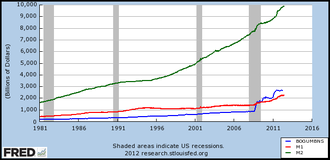
Coin Base, M1 and M2 in the U.South. from 1981 to 2012
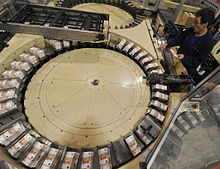
Printing newspaper coin at a printing press in Perm
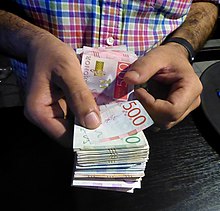
A person counts a bundle of different Swedish banknotes.
In economics, money is whatever fiscal instrument that can fulfill the functions of money (detailed higher up). These financial instruments together are collectively referred to as the coin supply of an economy. In other words, the money supply is the number of fiscal instruments within a specific economic system available for purchasing goods or services. Since the money supply consists of various financial instruments (usually currency, demand deposits, and various other types of deposits), the amount of money in an economy is measured past calculation together these financial instruments creating a monetary aggregate.
Mod monetary theory distinguishes among different ways to measure the stock of money or money supply, reflected in different types of monetary aggregates, using a categorization organization that focuses on the liquidity of the financial instrument used as money. The most normally used monetary aggregates (or types of coin) are conventionally designated M1, M2, and M3. These are successively larger aggregate categories: M1 is currency (coins and bills) plus demand deposits (such every bit checking accounts); M2 is M1 plus savings accounts and time deposits under $100,000; M3 is M2 plus larger time deposits and like institutional accounts. M1 includes only the virtually liquid fiscal instruments, and M3 relatively illiquid instruments. The precise definition of M1, M2, etc. may be unlike in unlike countries.
Another measure of money, M0, is as well used; dissimilar the other measures, it does non represent actual purchasing power by firms and households in the economy.[ commendation needed ] M0 is base coin, or the amount of money actually issued past the central bank of a state. It is measured as currency plus deposits of banks and other institutions at the central bank. M0 is also the but money that can satisfy the reserve requirements of commercial banks.
Creation of coin
In current economical systems, money is created by two procedures:
Legal tender, or narrow money (M0) is the greenbacks created by a Key Banking company by minting coins and press banknotes.
Bank coin, or broad coin (M1/M2) is the money created by private banks through the recording of loans as deposits of borrowing clients, with fractional back up indicated by the cash ratio. Currently, bank coin is created as electronic money.
In near countries, the bulk of money is mostly created as M1/M2 past commercial banks making loans. Contrary to some pop misconceptions, banks do not act simply every bit intermediaries, lending out deposits that savers place with them, and practice not depend on central bank money (M0) to create new loans and deposits.[29]
Marketplace liquidity
"Marketplace liquidity" describes how easily an item can be traded for another item, or into the common currency within an economic system. Money is the most liquid asset considering it is universally recognized and accustomed every bit a common currency. In this style, money gives consumers the freedom to merchandise goods and services easily without having to barter.
Liquid fiscal instruments are easily tradable and accept depression transaction costs. In that location should be no (or minimal) spread between the prices to buy and sell the instrument being used as coin.
Types
Commodity

Many items take been used every bit commodity money such every bit naturally scarce precious metals, conch shells, barley, beads, etc., as well equally many other things that are idea of as having value. Article money value comes from the article out of which information technology is fabricated. The commodity itself constitutes the money, and the coin is the commodity.[30] Examples of commodities that have been used every bit mediums of exchange include aureate, silver, copper, rice, Wampum, salt, peppercorns, big stones, decorated belts, shells, alcohol, cigarettes, cannabis, candy, etc. These items were sometimes used in a metric of perceived value in conjunction with one some other, in various commodity valuation or cost system economies. The use of commodity money is similar to barter, just a article money provides a simple and automatic unit of account for the commodity which is being used as money. Although some gold coins such as the Krugerrand are considered legal tender, there is no record of their face value on either side of the coin. The rationale for this is that emphasis is laid on their direct link to the prevailing value of their fine gilded content.[31] American Eagles are imprinted with their gold content and legal tender face value.[32]
Representative
In 1875, the British economist William Stanley Jevons described the money used at the fourth dimension as "representative coin". Representative money is coin that consists of token coins, paper money or other physical tokens such every bit certificates, that can exist reliably exchanged for a fixed quantity of a commodity such as gilded or silver. The value of representative money stands in directly and stock-still relation to the commodity that backs it, while not itself being composed of that commodity.[33]
Fiat
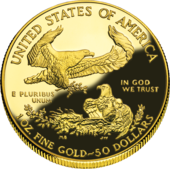
Gold coins are an example of legal tender that are traded for their intrinsic value, rather than their face value.
Fiat money or fiat currency is coin whose value is not derived from any intrinsic value or guarantee that it tin be converted into a valuable commodity (such as gold). Instead, it has value only by government order (fiat). Usually, the government declares the fiat currency (typically notes and coins from a central bank, such as the Federal Reserve Organization in the U.S.) to be legal tender, making it unlawful not to accept the fiat currency as a means of repayment for all debts, public and private.[34] [35]
Some bullion coins such as the Australian Gold Nugget and American Hawkeye are legal tender, all the same, they trade based on the marketplace cost of the metal content as a commodity, rather than their legal tender confront value (which is usually only a small fraction of their bullion value).[32] [36]
Fiat coin, if physically represented in the grade of currency (paper or coins), tin be accidentally damaged or destroyed. However, fiat money has an advantage over representative or commodity money, in that the same laws that created the money can likewise define rules for its replacement in instance of damage or destruction. For example, the U.S. government will replace mutilated Federal Reserve Notes (U.South. fiat money) if at least half of the physical note can be reconstructed, or if it tin can be otherwise proven to have been destroyed.[37] Past contrast, article money that has been lost or destroyed cannot exist recovered.
Coinage
These factors led to the shift of the store of value being the metal itself: at first silver, then both silver and gold, and at i point there was statuary as well. Now nosotros have copper coins and other not-precious metals as coins. Metals were mined, weighed, and stamped into coins. This was to assure the individual taking the coin that he was getting a certain known weight of precious metal. Coins could be counterfeited, but they also created a new unit of business relationship, which helped atomic number 82 to cyberbanking. Archimedes' principle provided the next link: coins could at present be hands tested for their fine weight of the metallic, and thus the value of a money could exist adamant, even if information technology had been shaved, debased or otherwise tampered with (see Numismatics).
In most major economies using coinage, copper, silver, and golden formed three tiers of coins. Gilt coins were used for large purchases, payment of the armed services, and backing of state activities. Argent coins were used for midsized transactions, and as a unit of account for taxes, dues, contracts, and fealty, while copper coins represented the coinage of mutual transaction. This system had been used in aboriginal Republic of india since the time of the Mahajanapadas. In Europe, this system worked through the medieval period because there was virtually no new gold, silver, or copper introduced through mining or conquest.[ commendation needed ] Thus the overall ratios of the three coinages remained roughly equivalent.
Paper
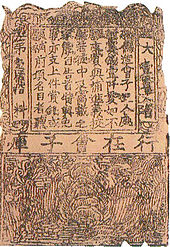
In premodern China, the need for credit and for circulating a medium that was less of a burden than exchanging thousands of copper coins led to the introduction of paper money, commonly known today equally "banknote"southward. This economic phenomenon was a slow and gradual procedure that took place from the late Tang dynasty (618–907) into the Vocal dynasty (960–1279). It began as a means for merchants to exchange heavy coinage for receipts of eolith issued as promissory notes from shops of wholesalers, notes that were valid for temporary use in a small regional territory. In the 10th century, the Vocal dynasty government began circulating these notes amongst the traders in their monopolized salt industry. The Song government granted several shops the sole correct to issue banknotes, and in the early 12th century the government finally took over these shops to produce state-issued currency. Even so the banknotes issued were still regionally valid and temporary; information technology was not until the mid 13th century that a standard and uniform government issue of paper coin was made into an acceptable nationwide currency. The already widespread methods of woodblock printing then Pi Sheng'south movable blazon printing past the 11th century was the impetus for the massive product of paper money in premodern China.

Paper coin from dissimilar countries
At effectually the same time in the medieval Islamic world, a vigorous monetary economy was created during the seventh–12th centuries on the basis of the expanding levels of circulation of a stable loftier-value currency (the dinar). Innovations introduced past economists, traders and merchants of the Muslim globe include the earliest uses of credit,[38] cheques, savings accounts, transactional accounts, loaning, trusts, commutation rates, the transfer of credit and debt,[39] and banking institutions for loans and deposits.[39] [ demand quotation to verify ]
In Europe, paper coin was offset introduced in Sweden in 1661. Sweden was rich in copper, thus, because of copper's low value, extraordinarily big coins (often weighing several kilograms) had to be made. The advantages of paper currency were numerous: it reduced transport of gold and silver, and thus lowered the risks; it fabricated loaning gold or silverish at interest easier since the specie (gold or silver) never left the possession of the lender until someone else redeemed the note; it allowed for a division of currency into credit and specie backed forms. Information technology enabled the auction of stock in joint stock companies, and the redemption of those shares in the paper.
Withal, these advantages are held within their disadvantages. First, since a note has no intrinsic value, there was nada to finish issuing authorities from press more than of it than they had specie to dorsum it with. 2d, because it increased the money supply, information technology increased inflationary pressures, a fact observed by David Hume in the 18th century. The result is that paper money would oft atomic number 82 to an inflationary bubble, which could collapse if people began demanding hard money, causing the demand for paper notes to autumn to goose egg. The printing of paper money was also associated with wars, and financing of wars, and therefore regarded as role of maintaining a standing army. For these reasons, newspaper currency was held in suspicion and hostility in Europe and America. It was also addictive since the speculative profits of trade and capital creation were quite big. Major nations established mints to impress money and mint coins, and branches of their treasury to collect taxes and agree gilt and silver stock.
At this time both silver and gilt were considered legal tender, and accepted by governments for taxes. Withal, the instability in the ratio between the two grew over the 19th century, with the increase both in the supply of these metals, peculiarly silverish, and of merchandise. This is called bimetallism and the attempt to create a bimetallic standard where both aureate and silvery backed currency remained in apportionment occupied the efforts of inflationists. Governments at this point could utilize currency every bit an musical instrument of policy, printing paper currency such as the U.s.a. greenback, to pay for military expenditures. They could also set the terms at which they would redeem notes for specie, past limiting the amount of purchase, or the minimum amount that could be redeemed.

Banknotes of different currencies with a face value of 5000
By 1900, most of the industrializing nations were on some grade of a gold standard, with paper notes and argent coins constituting the circulating medium. Private banks and governments across the earth followed Gresham'due south law: keeping aureate and silverish paid simply paying out in notes. This did not happen all around the world at the aforementioned time, just occurred sporadically, by and large in times of war or financial crisis, commencement in the early role of the 20th century and continuing across the world until the late 20th century, when the government of floating fiat currencies came into force. One of the last countries to break away from the gold standard was the The states in 1971.
No country anywhere in the globe today has an enforceable gold standard or silver standard currency arrangement.
Commercial bank
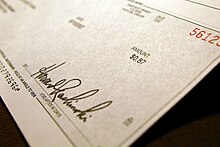
A check, used as a ways of converting funds in a demand deposit to greenbacks
Commercial depository financial institution money or demand deposits are claims against financial institutions that can be used for the purchase of appurtenances and services. A need deposit account is an business relationship from which funds can be withdrawn at whatever fourth dimension by bank check or cash withdrawal without giving the bank or financial institution any prior detect. Banks have the legal obligation to return funds held in demand deposits immediately upon demand (or 'at telephone call'). Need deposit withdrawals tin be performed in person, via checks or banking company drafts, using automatic teller machines (ATMs), or through online banking.[forty]
Commercial banking concern money is created through fractional-reserve banking, the banking do where banks proceed merely a fraction of their deposits in reserve (as cash and other highly liquid assets) and lend out the remainder, while maintaining the simultaneous obligation to redeem all these deposits upon demand.[41] [ page needed ] [42] Commercial depository financial institution money differs from commodity and fiat money in ii ways: firstly it is non-physical, as its existence is but reflected in the account ledgers of banks and other financial institutions, and secondly, there is some element of risk that the merits will not be fulfilled if the fiscal establishment becomes insolvent. The process of partial-reserve cyberbanking has a cumulative issue of money cosmos by commercial banks, as it expands the money supply (cash and demand deposits) beyond what it would otherwise be. Considering of the prevalence of partial reserve banking, the broad money supply of most countries is a multiple (greater than 1) of the corporeality of base money created by the state's cardinal bank. That multiple (chosen the money multiplier) is adamant by the reserve requirement or other financial ratio requirements imposed by financial regulators.
The coin supply of a land is usually held to exist the total amount of currency in circulation plus the total value of checking and savings deposits in the commercial banks in the land. In mod economies, relatively picayune of the coin supply is in physical currency. For instance, in December 2010 in the U.Southward., of the $8853.4 billion in broad money supply (M2), only $915.7 billion (almost ten%) consisted of concrete coins and paper money.[43]
Digital or electronic
The development of reckoner applied science in the second office of the twentieth century immune money to be represented digitally. By 1990, in the United States all coin transferred betwixt its cardinal bank and commercial banks was in electronic grade. By the 2000s virtually money existed as digital currency in bank databases.[44] In 2012, by number of transaction, 20 to 58 per centum of transactions were electronic (dependent on land).[45]
Not-national digital currencies were developed in the early on 2000s. In detail, Flooz and Beenz had gained momentum earlier the Dot-com bubble.[ citation needed ] Non much innovation occurred until the conception of Bitcoin in 2008, which introduced the concept of a cryptocurrency – a decentralised trustless currency.[46]
Budgetary policy
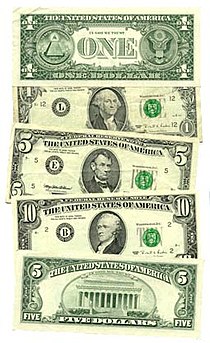
When aureate and silver are used as money, the money supply tin abound only if the supply of these metals is increased by mining. This charge per unit of increase will accelerate during periods of golden rushes and discoveries, such as when Columbus traveled to the New World and brought dorsum aureate and silver to Spain, or when golden was discovered in California in 1848. This causes aggrandizement, as the value of gold goes downwards. Still, if the charge per unit of gilt mining cannot keep upward with the growth of the economy, gilded becomes relatively more valuable, and prices (denominated in gold) will driblet, causing deflation. Deflation was the more than typical situation for over a century when gold and paper money backed by gold were used as money in the 18th and 19th centuries.
Mod-mean solar day monetary systems are based on fiat money and are no longer tied to the value of gilt. The control of the amount of coin in the economic system is known equally monetary policy. Monetary policy is the process by which a government, central depository financial institution, or monetary say-so manages the money supply to achieve specific goals. Usually, the goal of monetary policy is to accommodate economic growth in an environment of stable prices. For instance, it is clearly stated in the Federal Reserve Deed that the Board of Governors and the Federal Open up Market Commission should seek "to promote effectively the goals of maximum employment, stable prices, and moderate long-term interest rates."[47]
A failed monetary policy can take significant detrimental furnishings on an economy and the society that depends on it. These include hyperinflation, stagflation, recession, high unemployment, shortages of imported goods, inability to export goods, and even total monetary collapse and the adoption of a much less efficient barter economy. This happened in Russian federation, for instance, later on the autumn of the Soviet Marriage.
Governments and fundamental banks have taken both regulatory and complimentary market approaches to monetary policy. Some of the tools used to control the coin supply include:
- changing the interest charge per unit at which the central bank loans money to (or borrows money from) the commercial banks
- currency purchases or sales
- increasing or lowering authorities borrowing
- increasing or lowering regime spending
- manipulation of commutation rates
- raising or lowering depository financial institution reserve requirements
- regulation or prohibition of individual currencies
- taxation or tax breaks on imports or exports of capital into a land
In the U.s., the Federal Reserve is responsible for controlling the money supply, while in the Euro surface area the corresponding institution is the European Central Depository financial institution. Other central banks with a pregnant impact on global finances are the Bank of Nihon, People's Bank of China and the Bank of England.
For many years much of monetary policy was influenced past an economic theory known equally monetarism. Monetarism is an economic theory which argues that direction of the money supply should be the chief ways of regulating economic activity. The stability of the demand for money prior to the 1980s was a key finding of Milton Friedman and Anna Schwartz[48] supported by the work of David Laidler,[49] and many others. The nature of the demand for coin changed during the 1980s attributable to technical, institutional, and legal factors[ description needed ] and the influence of monetarism has since decreased.
Locality

The definition of coin says it is coin only "in a particular country or socio-economic context". In general, communities simply use a unmarried mensurate of value, which tin can be identified in the prices of goods listed for auction. There might be multiple media of substitution, which can be observed by what is given to purchase goods ("medium of substitution"), etc. In about countries, the government acts to encourage a item forms of coin, such as requiring it for taxes and punishing fraud.
Some places practise maintain 2 or currencies, especially in edge towns or high-travel areas. Shops in these locations might list prices and have payment in multiple currencies. Otherwise, foreign currency is treated equally an financial asset in the local market. Foreign currency is normally bought or sold on foreign substitution markets by travelers and traders.
Communities can change the coin they use, which is known as currency substitution. This can happen intentionally, when a government issues a new currency. For example, when Brazil moved from the Brazilian cruzeiro to the Brazilian real. It tin also happen spontaneously, when the people turn down to take a currency experiencing hyperinflation (even if its employ is encouraged by the government).
The money used by a community can alter on a smaller calibration. This can come through innovation, such equally the adoption of cheques (checks). Gresham's law says that "bad money drives out good". That is, when buying a skillful, a person is more likely to pass on less-desirable items that qualify as "money" and concur on to more than valuable ones. For example, coins with less argent in them (but which are still valid coins) are more probable to circulate in the community. This may effectively modify the money used past a community.
The money used by a community does non accept to be a currency issued past a government. A famous example of community adopting a new course of money is prisoners-of-war using cigarettes to trade.[50]
Financial crimes
Counterfeiting
Counterfeit coin is imitation currency produced without the legal sanction of the state or authorities. Producing or using counterfeit money is a class of fraud or forgery. Counterfeiting is virtually as old equally coin itself. Plated copies (known every bit Fourrées) accept been plant of Lydian coins which are thought to exist amid the first western coins.[51] Historically, objects that were hard to counterfeit (due east.g. shells, rare stones, precious metals) were often chosen every bit coin.[52] Before the introduction of paper money, the well-nigh prevalent method of counterfeiting involved mixing base metals with pure gold or silvery. A form of counterfeiting is the product of documents by legitimate printers in response to fraudulent instructions. During World War Ii, the Nazis forged British pounds and American dollars. Today some of the finest counterfeit banknotes are called Superdollars because of their high quality and likeness to the existent U.S. dollar. There has been significant counterfeiting of Euro banknotes and coins since the launch of the currency in 2002, simply considerably less than for the U.S. dollar.[53]
Coin laundering
Money laundering is the process in which the proceeds of crime are transformed into ostensibly legitimate money or other assets. However, in several legal and regulatory systems the term money laundering has become conflated with other forms of financial law-breaking, and sometimes used more generally to include misuse of the fiscal organization (involving things such as securities, digital currencies, credit cards, and traditional currency), including terrorism financing, taxation evasion, and evading of international sanctions.
See as well
- Calculation in kind
- Coin of account
- Commons-based peer production
- Digital currency
- Finance
- Foreign commutation market
- Souvenir economy
- Intelligent banknote neutralisation arrangement
- Labour voucher
- Leprosy colony coin
- Local exchange trading system
- Money pocketbook
- Money management
- Orders of magnitude (currency)
- Seigniorage
- Slang terms for money
- Social capital letter
- Velocity of Money
- World currency
- Apocryphal money
References
- ^ Mishkin, Frederic South. (2007). The Economics of Coin, Banking, and Financial Markets (Alternating ed.). Boston: Addison Wesley. p. 8. ISBN978-0-321-42177-vii.
- ^ What Is Money? By John N. Smithin. Retrieved July-17-09.
- ^ "money : The New Palgrave Dictionary of Economics". The New Palgrave Dictionary of Economics . Retrieved 18 December 2010.
- ^ a b c d eastward Mankiw, N. Gregory (2007). "ii". Macroeconomics (6th ed.). New York: Worth Publishers. pp. 22–32. ISBN978-0-7167-6213-three.
- ^ a b c T.H. Greco. Coin: Understanding and Creating Alternatives to Legal Tender, White River Junction, Vt: Chelsea Green Publishing (2001). ISBN ane-890132-37-iii
- ^ "The Etymology of Money". Thewallstreetpsychologist.com. Archived from the original on iii April 2015. Retrieved 24 February 2015.
- ^ Boyle, David (2006). The Little Money Book. The Disinformation Company. p. 37. ISBN978-one-932857-26-9.
- ^ "History of Money". Zzaponline.com. Archived from the original on 24 Feb 2015. Retrieved 24 February 2015.
- ^ Bernstein, Peter, A Primer on Money and Banking, and Gold, Wiley, 2008 edition, pp. 29–39
- ^ D'Eprio, Peter & Pinkowish, Mary Desmond (1998). What Are the Seven Wonders of the World? First Anchor Books, p. 192. ISBN 0-385-49062-3
- ^ "Online Etymology Dictionary". etymonline.com. Retrieved 2009-04-20 .
- ^ Mauss, Marcel. The Gift: The Class and Reason for Substitution in Archaic Societies. pp. 36–37.
- ^ "The Myth of the Myth of the Myth of Barter and the Return of the Armchair Ethnologists". Bella Caledonia. 2016-06-08. Retrieved 2020-02-12 .
- ^ "What is Debt? – An Interview with Economical Anthropologist David Graeber". Naked Commercialism. 2011-08-26.
- ^ David Graeber: Debt: The Kickoff 5000 Years, Melville 2011. Cf. review
- ^ David Graeber (2001). Toward an anthropological theory of value: the false money of our own dreams. Palgrave Macmillan. pp. 153–154. ISBN978-0-312-24045-5 . Retrieved ten Feb 2011.
- ^ Kramer, History Begins at Sumer, pp. 52–55.
- ^ Herodotus. Histories, I, 94
- ^ Goldsborough, Reid (2003-10-02). "Earth'southward Showtime Coin". rg.ancients.info. Retrieved 2009-04-20 .
- ^ Moshenskyi, Sergii (2008). History of the weksel: Bill of exchange and promissory note. p. 55. ISBN978-1-4363-0694-2.
- ^ Marco Polo (1818). The Travels of Marco Polo, a Venetian, in the Thirteenth Century: Beingness a Clarification, by that Early Traveller, of Remarkable Places and Things, in the Eastern Parts of the Globe. pp. 353–355. Retrieved 19 September 2012.
- ^ Wray, 50. Randall (2012). Modern money theory: a primer on macroeconomics for sovereign monetary systems. Houndmills, Basingstoke, Hampshire: Palgrave Macmillan. pp. 45–50. ISBN978-0230368897.
- ^ Milnes, Alfred (1919). The economical foundations of reconstruction. Macdonald and Evans. p. 55.
- ^ Dwivedi, DN (2005). Macroeconomics: Theory and Policy. Tata McGraw-Colina. p. 182.
- ^ a b Krugman, Paul & Wells, Robin, Economic science, Worth Publishers, New York (2006)
- ^ a b Abel, Andrew; Bernanke, Ben (2005). "7". Macroeconomics (fifth ed.). Pearson. pp. 266–269. ISBN978-0-201-32789-2.
- ^ "Functions of Coin". boundless.com. 2017-10-11. Archived from the original on October 18, 2015.
- ^ a b c Desjardins, Jeff (Dec 15, 2015). "Infographic: The Backdrop of Money". The Money Projection. Retrieved eighteen July 2017.
- ^ "Coin cosmos in the modernistic economy | Bank of England". www.bankofengland.co.great britain . Retrieved 2018-01-14 .
- ^ Mises, Ludwig von. The Theory of Money and Credit, (Indianapolis, IN: Liberty Fund, Inc., 1981), trans. H. E. Batson. Ch.3 Function One: The Nature of Money, Chapter 3: The Various Kinds of Money, Section 3: Article Money, Credit Money, and Fiat Coin, Paragraph 25.
- ^ randRefinery.com Archived 2013-07-04 at WebCite. Retrieved July-18-09.
- ^ a b usmiNT.gov. Retrieved July-18-09.
- ^ Jevons, William Stanley (1875). "XVI: Representative Coin". Money and the Machinery of Substitution. ISBN978-ane-59605-260-iv . Retrieved 2009-06-28 .
- ^ Deardorff, Prof. Alan V. (2008). "Deardorff's Glossary of International Economics". Department of Economics, Academy of Michigan. Retrieved 2008-07-12 .
- ^ Black, Henry Campbell (1910). A Law Dictionary Containing Definitions Of The Terms And Phrases Of American And English language Jurisprudence, Ancient And Modern, p. 494. West Publishing Co. Black'southward Law Dictionary defines the discussion "fiat" to hateful "a brusque order or warrant of a Judge or magistrate directing some human activity to exist washed; an potency issuing from some competent source for the doing of some legal act"
- ^ Tom Bethell (1980-02-04). "Crazy as a Gold Bug". New York. Vol. 13, no. 5. New York Media. p. 34. Retrieved July-xviii-09
- ^ Shredded & Mutilated: Mutilated Currency, Bureau of Engraving and Press. Retrieved 2007-05-09.
- ^ Banaji, Jairus (2007). "Islam, the Mediterranean and the Rise of Commercialism". Historical Materialism. 15 (1): 47–74. doi:10.1163/156920607X171591. ISSN 1465-4466. OCLC 440360743. Archived from the original on May 23, 2009. Retrieved August 28, 2010.
- ^ a b Labib, Subhi Y. (March 1969). "Commercialism in Medieval Islam". The Journal of Economical History. 29 (i): 79–86. doi:10.1017/S0022050700097837. ISSN 0022-0507. JSTOR 2115499. OCLC 478662641.
- ^ O'Sullivan, Arthur; Sheffrin, Steven M. (2003). Economics: Principles in Activeness . Upper Saddle River, New Jersey: Pearson Prentice Hall. p. 258. ISBN978-0-xiii-063085-8.
- ^ The Bank Credit Assay Handbook: A Guide for Analysts, Bankers, and Investors by Jonathan Golin. Publisher: John Wiley & Sons (Baronial 10, 2001). ISBN 0-471-84217-half-dozen ISBN 978-0-471-84217-0
- ^ "Economic Definitions". Bankintroductions.com. Archived from the original on two February 2015. Retrieved 7 October 2014.
- ^ "FRB: H.6 Release – Coin Stock and Debt Measures". world wide web.federalreserve.gov. Jan 27, 2011.
- ^ "How Currency Works". 2 September 2003. Archived from the original on xxx July 2019. Retrieved 22 October 2018.
- ^ Eveleth, Rose. "The truth about the death of cash".
- ^ Wallace, Benjamin (23 Nov 2011). "The Rising and Fall of Bitcoin". Wired. Archived from the original on 31 October 2013. Retrieved 13 Oct 2012.
- ^ The Federal Reserve. 'Monetary Policy and the Economic system". (PDF) Board of Governors of the Federal Reserve System, (2005-07-05). Retrieved 2007-05-15.
- ^ Milton Friedman; Anna Jacobson Schwartz (1971). Monetary History of the United States, 1867–1960. Princeton, Due north.J: Princeton University Press. ISBN978-0-691-00354-2.
- ^ David Laidler (1997). Money and Macroeconomics: The Selected Essays of David Laidler (Economists of the Twentieth Century). Edward Elgar Publishing. ISBN978-1-85898-596-1.
- ^ Radford, R. A. (November 1945). "The Economic System of a P.O.W. Camp". Economica. 12 (48): 189–201. doi:10.2307/2550133. JSTOR 2550133.
- ^ "A Case for the Globe's Oldest Money". Retrieved 29 January 2013.
- ^ Gourinchas, Pierre-Olivier; Rey, Hélène; Sauzet, Maxime (2019). "The International Monetary and Fiscal System". Almanac Review of Economics. 11 (1): 859–893. doi:10.1146/annurev-economics-080217-053518. ISSN 1941-1383. S2CID 169545752.
- ^ "Counterfeiting statistics for several currencies". Itsamoneything.com. 2012-06-09. Retrieved 2014-09-21 .
Further reading
- Chown, John F. A History of Money: from Ad 800 (Psychology Press, 1994).
- Davies, Glyn, and Duncan Connors. A History of Money (4th ed. U of Wales Press, 2016) excerpt .
- Ferguson, Niall. The Ascent of Money: A Financial History of the Globe (2009) excerpt
- Keen, Steve (February 2015). "What Is Money and How Is It Created?" argues, "Banks create coin by issuing a loan to a borrower; they record the loan as an asset, and the money they eolith in the borrower'south business relationship as a liability. This, in one style, is no different to the fashion the Federal Reserve creates money ... money is merely a third party'due south promise to pay which nosotros accept as total payment in exchange for goods. The two master third parties whose promises we accept are the government and the banks ... money ... is not backed past anything concrete, and instead relies on trust. Of form, that trust can be abused ... nosotros proceed to ignore the main game: what the banks do (for practiced and for ill) that really drives the economy." Forbes
- Kuroda, Akinobu. A Global History of Coin (Routledge, 2020). extract
- Hartman, Mitchell (October 30, 2017). "How Much Money Is There in the Earth?". I've Always Wondered... (story series). Marketplace. American Public Media. Retrieved October 31, 2017.
- Lanchester, John, "The Invention of Money: How the heresies of two bankers became the basis of our modern economy", The New Yorker, 5 & 12 August 2019, pp. 28–31.
- Weatherford, Jack. The history of money (2009). by a cultural anthropologist. extract
External links
Source: https://en.wikipedia.org/wiki/Money
Posted by: peetehiecand.blogspot.com

0 Response to "Which Of The Following Combinations Of Assets Is Considered To Be Money?"
Post a Comment